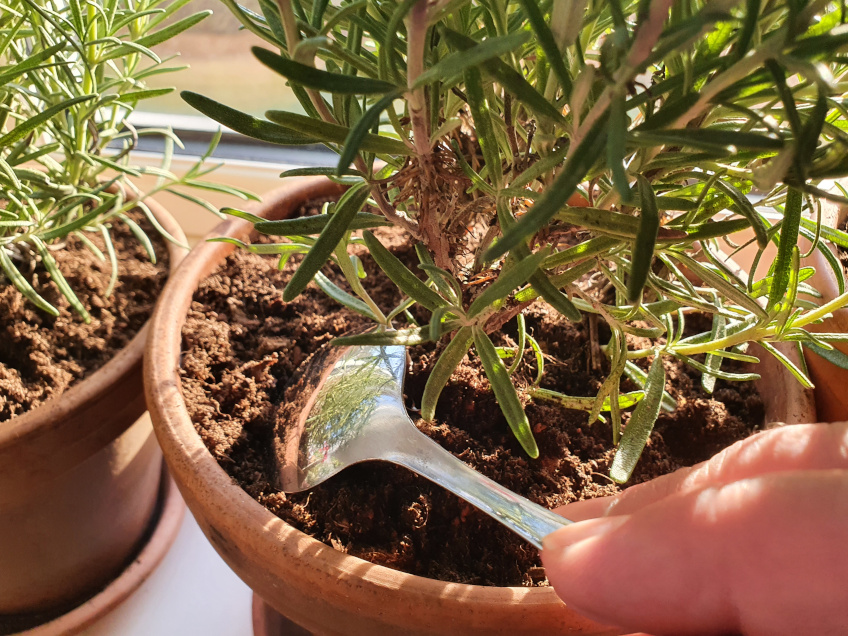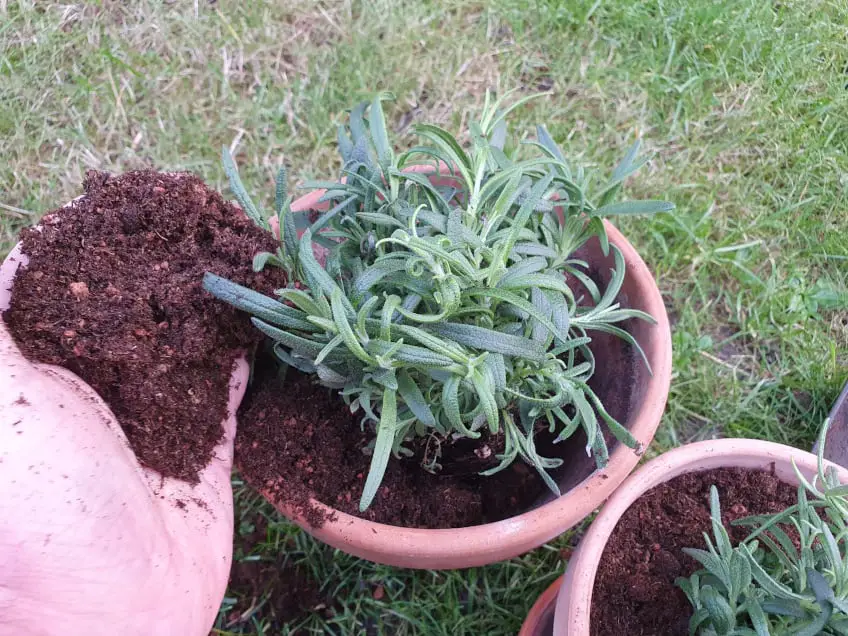If you notice mold on the soil your rosemary is growing in, you need to take care of it as soon as possible to save your plant. I have had this problem before and managed to solve it and save my plants. In this article, I will teach you how you can save yours too if you have the same problem including what you should do to prevent it from happening again.
The first thing you should do when you notice mold on the soil your rosemary is growing in is to scrape the mold off with a spoon, a knife, or similar. If there is a lot of mold, it can be necessary to transplant the rosemary to a larger pot with fresh soil.
Regardless if there is only a little bit of mold on your rosemary’s soil or if there is a lot, I explain precisely what you need to do to save your plant in this article. I also explain why mold suddenly appeared on your soil and what you should do differently to avoid it in the future.
What to Do About Small Amounts of Mold on Rosemary’s Soil
If you have noticed a small patch of mold on the soil your rosemary is growing, you need to act now to prevent it from turning into a bigger problem. Luckily, if there is only a little bit of mold, you have noticed it early and have a very good chance of saving the plant without much difficulty.

The easiest way I have found to get rid of mold on the soil of my plants is to scrape it off with a spoon, a knife, or similar like I do in the photo above. I like to use a spoon since it is easy to get underneath the mold and get all of it.
It is important that you see if the mold is only on the soil or if it has spread to the plant itself. If you see mold on any parts of the plant, you should cut those parts off and discard them.
Mold usually appears on soil because there is too much moisture. To reduce the risk, make sure you are not overwatering your rosemary (you can read more about that on this link) and move it to a spot that gets a lot of direct sunlight and has good airflow. This will help the soil dry out properly, which helps prevent mold.
Keep checking back every day for 1-2 weeks to see if the mold comes back.
Scraping the mold off the soil is only sufficient if there is only a little bit of it, though. If there is a lot or it keeps coming back, you should still scrape as much as possible off, but you most likely also have to take more drastic methods into use, so let’s get into that now.
What to Do if There Is a Lot of Mold or It Keeps Coming Back
Mold can spread very fast, so if you don’t notice it early and do something about it, it can easily end up covering the entire surface of the soil around your rosemary, which can seem overwhelming.
If there is a lot of mold on the soil around your rosemary or the mold keeps coming back after you scrape it off, you need to take stronger methods into use.

If there is a lot of mold on the soil around your rosemary, you should still try to scrape off as much as possible, as I explained earlier in this article.
This usually isn’t enough to make the problem go away if it is severe enough, though.
I have found that the best thing you can do in this situation is to transplant your rosemary to a larger pot with a lot of fresh soil. I have a guide where I show and explain how to do that on this link.
Place the plant in a sunny spot with good airflow to significantly reduce the risk of mold and other moisture-related issues.
Once you have done these things, you need to identify the underlying problem to prevent the mold from coming back. Keep reading as I get into that now.
Why Mold Appears on Rosemary’s Soil and How to Avoid It
Mold appears in places with too much moisture. There are a couple of things that can cause soil to become too moist, so you need to identify the cause of the problem and solve it. Luckily, the cause is almost always the same.
Overwatering is a very common reason for excess moisture in soil. If you water your plants more than they need, the excess water will stay in the soil for a while, which can cause mold to appear in and on top of the soil.
If the soil doesn’t drain well or there is poor airflow around the plant, the risk of mold and other issues is also significantly higher since it causes the soil to dry out slower.
Removing the mold is an important first step, but you need to change some things to prevent it from coming back.
Of course, knowing how to water your rosemary correctly is the absolute best thing you can do to avoid this issue, which is precisely why I wrote the guide on this link. In it, I explain everything you need to know about how to water your specific rosemary correctly. That said, I also share some quick tips here below.
7 things you should do to avoid mold on your rosemary’s soil
- Place your rosemary in a sunny spot.
Rosemary needs high amounts of direct sunlight to thrive. If it doesn’t get much sunlight, it won’t be able to obtain and use so much water, which increases the risk of mold since there will be excess water in the soil. You can read more about how to help your rosemary get the sunlight it needs in the article on this link.
- Grow your rosemary in a pot or container with drainage holes.
Drainage holes are important since they allow most excess water to easily run through the pot rather than staying in the soil.
- Grow your rosemary in well-draining soil.
Light and well-drained soil is important for rosemary. The easiest way I have found to achieve this is to use soil with a high content of sand.
- Allow the soil to dry out before you water your rosemary.
It is very common to use too much water or to water rosemary too often. If you have had problems with mold, you should try to turn your watering down a bit. Allow the soil to dry out before you water.
- Water your potted rosemary from the bottom.
Instead of pouring water on top of the soil, pour it into the plate underneath the pot. This allows the soil and plant to obtain the water through the bottom, which reduces the amount of moisture at the surface, thereby reducing the risk of mold. This is one advantage of bottom-watering rosemary, but not the only one. I have written another article, where you can learn more about it.
- Remove excess water from the plate underneath your rosemary’s pot.
If there is still water in the plate underneath your rosemary’s pot about 20 minutes after you water it, you should remove the water since the plant already has all the water it needs.
- Clean the pot that had mold in it thoroughly.
It is important that you clean the pot that had mold in it thoroughly before you start using it again to prevent it from coming back. I like to wash my pots thoroughly with natural soap and a lot of water and then let them stay in the sun until it is completely dry.
